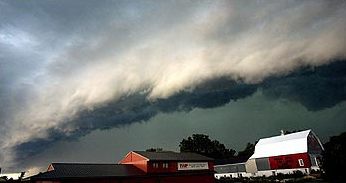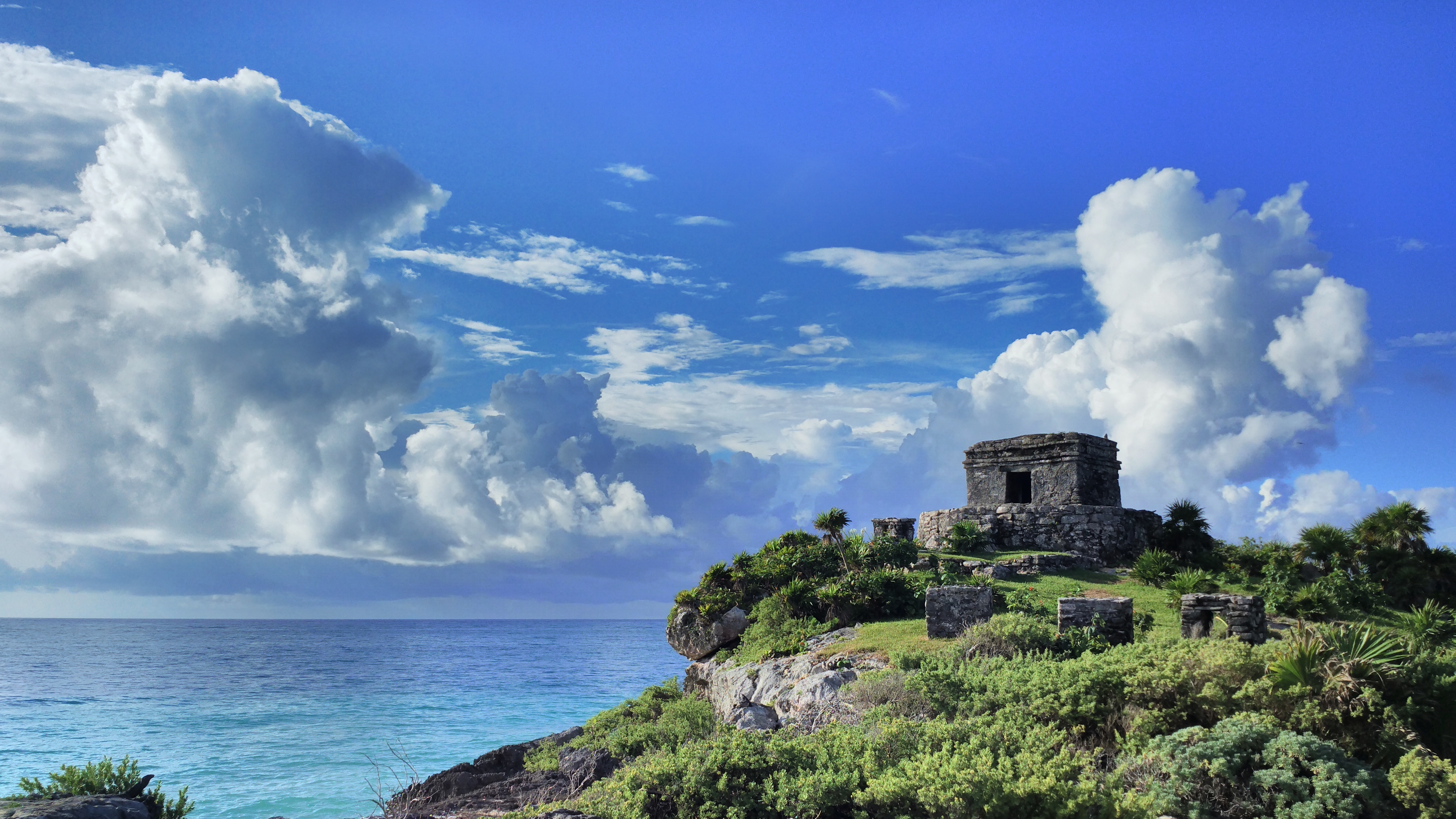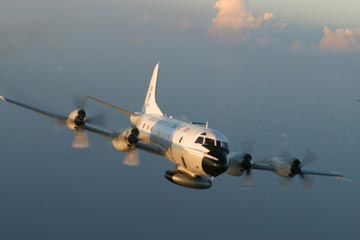|
Hurricane Janet
Hurricane Janet was the most powerful tropical cyclone of the 1955 Atlantic hurricane season and one of the strongest Atlantic hurricanes on record. Janet was also the first named storm to cause 1,000 deaths and the first Category 5 storm name to be retired. The eleventh tropical storm, ninth hurricane, and fourth major hurricane of the year, Janet formed from a tropical wave east of the Lesser Antilles on September 21. Moving westward across the Caribbean Sea, Janet fluctuated in intensity, but generally strengthened before reaching its peak intensity as a Category 5 hurricane with winds of . The intense hurricane later made landfall at that intensity near Chetumal, Mexico on September 28. After weakening over the Yucatán Peninsula, it moved into the Bay of Campeche, where it slightly strengthened before making its final landfall near Veracruz on September 29. Janet quickly weakened over Mexico's mountainous terrain before dissipating on September 30. In its developmental ... [...More Info...] [...Related Items...] OR: [Wikipedia] [Google] [Baidu] |
Surface Weather Analysis
Surface weather analysis is a special type of weather map that provides a view of weather elements over a geographical area at a specified time based on information from ground-based weather stations. Weather maps are created by plotting or tracing the values of relevant quantities such as sea level pressure, temperature, and cloud cover onto a geographical map to help find synoptic scale features such as weather fronts. The first weather maps in the 19th century were drawn well after the fact to help devise a theory on storm systems.Eric R. MillerAmerican Pioneers in Meteorology.Retrieved on 2007-04-18. After the advent of the telegraph, simultaneous surface weather observations became possible for the first time, and beginning in the late 1840s, the Smithsonian Institution became the first organization to draw real-time surface analyses. Use of surface analyses began first in the United States, spreading worldwide during the 1870s. Use of the Norwegian cyclone model for fronta ... [...More Info...] [...Related Items...] OR: [Wikipedia] [Google] [Baidu] |
Bay Of Campeche
The Bay of Campeche (), or Campeche Sound, is a bight in the southern area of the Gulf of Mexico, forming the north side of the Isthmus of Tehuantepec. It is surrounded on three sides by the Mexican states of Campeche, Tabasco and Veracruz. The area of the bay is and maximum depth of the bay is approximately . It was named by Francisco Hernández de Córdoba and Antón de Alaminos during their expedition in 1517. Oil resources The Cantarell Complex of five oil fields lies beneath the Bay of Campeche. In 2003, it was the second most productive oil field in the world, then supplying about two thirds of Mexico's crude oil output, but it went into a steep decline soon thereafter. On June 3, 1979, '' Ixtoc I'', an exploratory oil well located in the bay, suffered a blowout that caused a catastrophic explosion, resulting in what has been ranked as the third largest unintentional oil spill in history. Climate During the months of June and July, the Bay of Campeche is considered ... [...More Info...] [...Related Items...] OR: [Wikipedia] [Google] [Baidu] |
1935 Labor Day Hurricane
The 1935 Labor Day hurricane was an extremely powerful and devastating Atlantic hurricane that struck the southeastern United States in early September 1935. For several decades, it was the most intense Atlantic hurricane on record in terms of barometric pressure until being surpassed by Hurricane Gilbert in 1988; the strongest Atlantic hurricane on record in terms of 1-minute sustained winds (surpassed by Hurricane Allen in 1980); and the strongest at landfall by 1-minute sustained winds (tied with Hurricane Dorian in 2019). The fourth tropical cyclone, third tropical storm, second hurricane, and second major hurricane of the 1935 Atlantic hurricane season, it is one of four Category 5 hurricanes on record to strike the contiguous United States, along with Hurricane Camille (1969), Hurricane Andrew (1992), and Hurricane Michael (2018). The hurricane intensified rapidly during its time, passing near Long Key on Labor Day evening, September 2. The region was swept by a m ... [...More Info...] [...Related Items...] OR: [Wikipedia] [Google] [Baidu] |
Atmospheric Pressure
Atmospheric pressure, also known as air pressure or barometric pressure (after the barometer), is the pressure within the atmosphere of Earth. The standard atmosphere (symbol: atm) is a unit of pressure defined as , which is equivalent to 1,013.25 millibars, 760 mm Hg, 29.9212 inchesHg, or 14.696 psi.International Civil Aviation Organization. ''Manual of the ICAO Standard Atmosphere'', Doc 7488-CD, Third Edition, 1993. . The atm unit is roughly equivalent to the mean sea-level atmospheric pressure on Earth; that is, the Earth's atmospheric pressure at sea level is approximately 1 atm. In most circumstances, atmospheric pressure is closely approximated by the hydrostatic pressure caused by the weight of air above the measurement point. As elevation increases, there is less overlying atmospheric mass, so atmospheric pressure decreases with increasing elevation. Because the atmosphere is thin relative to the Earth's radius—especially the dense atmospheric layer at low altitu ... [...More Info...] [...Related Items...] OR: [Wikipedia] [Google] [Baidu] |
Mainland
Mainland is defined as "relating to or forming the main part of a country or continent, not including the islands around it egardless of status under territorial jurisdiction by an entity" The term is often politically, economically and/or demographically more significant than politically associated remote territories, such as exclaves or oceanic islands situated outside the continental shelf. In geography, "mainland" can denote the continental part of any polity or the main island within an island nation. In geopolitics, "mainland" is sometimes used interchangeably with terms like metropole as an antonym to overseas territories. In the sense of " heartland", mainland is the opposite of periphery. In some language a separate concept of "mainland" is missing and is replaced with a "continental portion". The term is relative: in Tasmania, continental Australia is the mainland, while to residents of Flinders Island, the main island of Tasmania is also "the mainland", though ... [...More Info...] [...Related Items...] OR: [Wikipedia] [Google] [Baidu] |
Tampico
Tampico is a city and port in the southeastern part of the Mexican state of Tamaulipas. It is located on the north bank of the Pánuco River, about inland from the Gulf of Mexico, and directly north of the state of Veracruz. Tampico is the fifth-largest city in Tamaulipas, with a population of 314,418 in the city proper and 929,174 in the metropolitan area. During the period of Mexico's first oil boom in the early 20th century, the city was the "chief oil-exporting port of the Americas" and the second-busiest in the world, yielding great profits that were invested in the city's famous architecture, often compared to that of Venice and New Orleans.Dave Graham, "Crime-ridden state poses acid test for Mexican oil reform" ''Reuters,'' 25 June 2014, acces ... [...More Info...] [...Related Items...] OR: [Wikipedia] [Google] [Baidu] |
Hurricane Hilda (1955)
Hurricane Hilda was a strong Category 3 hurricane that was the second in a succession of three hurricanes to strike near Tampico, Mexico. The eighth named storm of the 1955 Atlantic hurricane season, Hilda formed from a tropical wave on September 10 near the Lesser Antilles. It quickly intensified while moving westward into a small hurricane, and it crossed over southeastern Cuba on September 13. There, it dropped heavy rainfall and produced gusty winds that destroyed 80% of the coffee crop in Oriente Province. In the eastern Cuban city of Baracoa, Hilda severely damaged the oldest church in the country. Damage totaled $2 million in Cuba, and there were four deaths. Later, the hurricane moved across the Northwestern Caribbean Sea making landfall in Grand Cayman, then further into the Northwestern Caribbean causing light damage in the sparsely populated region of the eastern Yucatán Peninsula. After reaching the Gulf of Mexico, Hilda strengthened to reach peak wind ... [...More Info...] [...Related Items...] OR: [Wikipedia] [Google] [Baidu] |
Hurricane Gladys (1955)
The 1955 Atlantic hurricane season was, at the time, the costliest season ever recorded, just ahead of the previous year. The hurricane season officially began on June 15, 1955, and ended on November 15, 1955. It was an extremely active season in terms of accumulated cyclone energy (ACE), but only slightly above average in terms of storm formation, with 13 recorded tropical cyclones. The first reported system of the year, January's Hurricane Alice, was later found to have formed on December 30, during the 1954 season. Alice caused relatively minor impact as it tracked through the Lesser Antilles and eastern Caribbean Sea. The first tropical cyclone to form in 1955, Tropical Storm Brenda, caused two deaths and minor damage along the Gulf Coast of the United States in early August. The quick succession of Hurricanes Connie and Diane caused significant flooding in the Northeastern United States, with nearly $1 billion (1955 USD, $11.05 billion in 20 ... [...More Info...] [...Related Items...] OR: [Wikipedia] [Google] [Baidu] |
Flood
A flood is an overflow of water (list of non-water floods, or rarely other fluids) that submerges land that is usually dry. In the sense of "flowing water", the word may also be applied to the inflow of the tide. Floods are of significant concern in agriculture, civil engineering and public health. Environmental issues, Human changes to the environment often increase the intensity and frequency of flooding. Examples for human changes are land use changes such as deforestation and Wetland conservation, removal of wetlands, changes in waterway course or flood controls such as with levees. Global environmental issues also influence causes of floods, namely climate change which causes an Effects of climate change on the water cycle, intensification of the water cycle and sea level rise. For example, climate change makes Extreme weather, extreme weather events more frequent and stronger. This leads to more intense floods and increased flood risk. Natural types of floods include riv ... [...More Info...] [...Related Items...] OR: [Wikipedia] [Google] [Baidu] |
Administrative Divisions Of Mexico
Mexico is a federal republic composed of 32 federative entities (): 31 states and Mexico City. According to the Constitution of Mexico, the states of the federation are free and sovereignty, sovereign in all matters concerning their internal affairs. Since 2016, Mexico City was made a fully autonomous entity on par with the states. Each state federative entity has its own congress and constitution. Overview The current structural hierarchy of Mexican administrative divisions are outlined by Constitution of Mexico as well as the constitutions and laws of federative entities. The laws together established the following levels of administrative divisions. The levels in bold are those regulated by the federal constitution. * List of states of Mexico, State () ** Intrastate region, Region () or district () — only in some states *** Municipalities of Mexico, Municipality () **** List of cities in Mexico, City (), town (), village (), or Localities of Mexico, others ***** Coloni ... [...More Info...] [...Related Items...] OR: [Wikipedia] [Google] [Baidu] |
Quintana Roo
Quintana Roo, officially the Free and Sovereign State of Quintana Roo, is one of the 31 states which, along with Mexico City, constitute the 32 administrative divisions of Mexico, federal entities of Mexico. It is divided into municipalities of Quintana Roo, 11 municipalities, and its capital city is Chetumal. Quintana Roo is located on the eastern part of the Yucatán Peninsula and is bordered by the states of Campeche to the west and Yucatán (state), Yucatán to the northwest, and by the Orange Walk District, Orange Walk and Corozal District, Corozal districts of Belize, along with an offshore borderline with Belize District to the south. As Mexico's easternmost state, Quintana Roo has a coastline to the east with the Caribbean Sea and to the north with the Gulf of Mexico. The state previously covered and shared a small border with Guatemala in the southwest of the state. However, in 2013, Mexico's Supreme Court of Justice of the Nation resolved the boundary dispute between ... [...More Info...] [...Related Items...] OR: [Wikipedia] [Google] [Baidu] |
Hurricane Hunters
Hurricane hunters, typhoon hunters, or cyclone hunters are aircrews that fly into tropical cyclones to gather weather data. In the United States, the organizations that fly these missions are the United States Air Force Reserve's 53rd Weather Reconnaissance Squadron and the National Oceanic and Atmospheric Administration's Hurricane Hunters. Such missions have also been flown by Navy units and other Air Force and NOAA units. Other organizations also fly these missions, such as Government Flying Service Hong Kong. The first crewed flight into a hurricane happened in 1943 when a pilot-trainer flew into a Category 1 hurricane near Galveston, Texas on a bet. In the past, before satellites were used to find tropical storms, military aircraft flew routine weather reconnaissance tracks to detect formation of tropical cyclones. While modern satellites have improved the ability of meteorologists to detect cyclones before they form, only aircraft are able to measure the interior ba ... [...More Info...] [...Related Items...] OR: [Wikipedia] [Google] [Baidu] |






